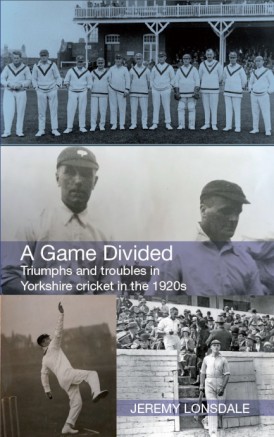A Game Divided
Martin Chandler |Published: 2020
Pages: 200
Author: Lonsdale, Jeremy
Publisher: ACS
Rating: 4 stars

A Game Divided is, effectively, a continuation of a history of cricket in Yorkshire that Jeremy Lonsdale began with A Game Taken Seriously in 2017, and continued last year with A Game Sustained. This third volume looks at the 1920s, an era when there was much less international cricket than there is now, and when the County Championship was the only prize that the First Class counties had to fight for.
Through the 1920s the Championship was won twice by Middlesex in 1920 and 1921, but after that it was the northern counties who dominated. Yorkshire won the title each year from 1922 to 1925, and only Nottinghamshire in 1929 prevented Lancashire from matching their great rival with four on the bounce. With Surrey and Kent these four were the ‘big six’, and throughout the decade on only four occasions did a county from outside their number finish in the top five.
Anyone who has read the two earlier books will not expect A Game Divided to be a simple season by season and man by man account of the period it covers and they will not be disappointed. The general theme is indicated in the book’s title, and is revealed in the first chapter. That is an account of a single match, that between Yorkshire and Middlesex at Sheffield in 1924, but it is not the cricket itself that is the main point.
Yorkshire were led by their usual captain, Geoffrey Wilson. Wilson led the county for three seasons, but as a player he was a makeweight. He was no bowler, and batted in the lower order ending with a career average of a mere 16. He was however an amateur, and in those days it was unthinkable that a county could be led by anyone else. Under Wilson’s nominal command were ten professionals. By 1924 seven of them were Test players, another would be in the future and the only two who weren’t were batsmen Edgar Oldroyd and legendary all-rounder Emmott Robinson, both of whom were long on ability and experience.
The composition of the Middlesex side was rather different. Led by Frank Mann, who had been England’s captain in South Africa two years previously, the visitors fielded just five professionals with an amateur contingent of six. The match itself was a draw, and was in the main a battle for first innings points that the visitors narrowly won. More significant was the hostility shown towards the visitors by the partisan Yorkshire crowd, something picked up on by the players, and particularly the Yorkshire left arm seamer Abe Waddington. It did not in the end come to pass, but the fall out was such that Middlesex considered declining to play against Yorkshire in the future.
Why did things come to that? Lonsdale looks at various factors. There was, then as now, a very different attitude to the grass roots of the game in the north, heartland of the competitive league structure, and the south of the country where league cricket was still decades away. With a few notable exceptions there was also the age old difference between amateurs and professionals. Players’ differing statuses impacted on matters as diverse as their attitudes to the playing of the game itself, and the control their counties could seek to exert on them.
Naturally in a book of this nature it is impossible for a Yorkshireman like Lonsdale not to treat his work, in part at least, as a celebration of the achievements of what was undoubtedly a candidate for the title of the strongest county side there has ever been. Just how good they were is something that he explores throughout his narrative, and particularly in the closing chapter that addresses the question in terms. After that there is an afterword that looks in a little more detail at some of the individuals that made up the side.
Finally, before a full index and the acknowledgments bring up the rear there are a few statistics that highlight some interesting issues. As many as eight counties did not beat Yorkshire at all throughout the 1920s, and they lost only twenty times in all. Of those twenty I was disappointed to note that only two of them were inflicted by Lancashire, which brings me to my only criticism of the book, that being its failure to devote a chapter to the Headingley Roses Match of 1924 when, chasing a mere 58 for victory, Yorkshire were skittled for 33 by Dick Tyldesley and Ciss Parkin.
The fact that there is only one complaint, and as Lonsdale will point out a baseless and irrelevant one at that, can only mean that A Game Divided is a worthy addition to Lonsdale’s oeuvre. I will look forward to the next instalment which will, I presume, cover the next great Yorkshire side, the one that came along just a few years later.






Leave a comment